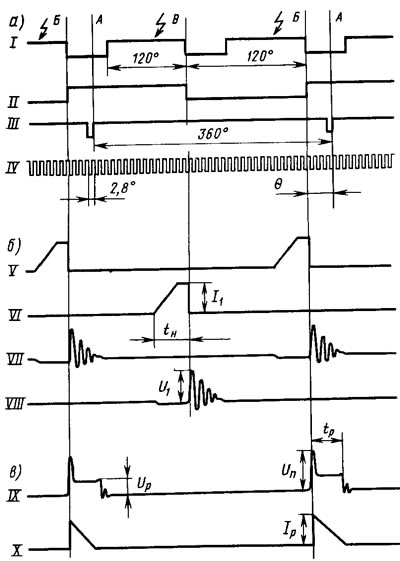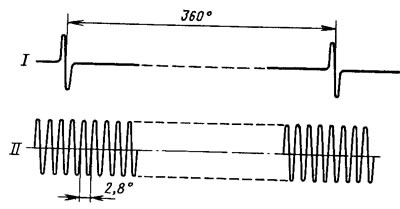Device Features
Microprocessor engine control system (MSUD) designed to control the ignition (moment and energy of sparking) and forced idle economizer solenoid valve (EPHH) carburetor. The system does not require any adjustments and maintenance in operation.
The system consists of a controller 10 (pic. 190) with built-in semiconductor pressure sensor, two-channel switch 4, ignition coils 2 and 3, spark plugs 1 and ignition switch 6, reference sensor 13, angle pulse sensor 12, coolant temperature sensor I, limit switch 8 of the carburetor throttle position and solenoid valve 9 EPHH of the carburetor.

Pic. 190. Scheme of the microprocessor control system of the engine: 1 - spark plugs; 2 - ignition coil of the 2nd and 3rd cylinders; 3 - ignition coil of the 1st and 4th cylinders; 4 - switch; 5 - block diagnosing; 6 - ignition switch; 7 - mounting block; 8 - carburetor limit switch; 9 - solenoid valve EPHH of the carburetor; 10 - controller; 11 - temperature sensor; 12 - sensor of angular impulses; 13 - reference sensor
Ignition control is carried out according to optimal characteristics, depending on:
- engine crankshaft speed;
- pressure in the inlet pipeline;
- coolant temperature;
- carburetor throttle position.
The carburetor EPHH solenoid valve is controlled depending on:
- engine crankshaft speed;
- carburetor throttle position.
Controller
Type «Electronics MS-2713-01» is a specialized microcomputer. It performs the following functions:
- using sensor signals, it measures the engine speed, intake manifold pressure, coolant temperature and determines the position of the throttle valve (closed or open) carburetor;
- based on the information received from the sensors, selects from the memory device the optimal ignition timing and the corresponding state (closed or open) solenoid valve EPHH of the carburetor;
- interpolates (calculation of intermediate values) ignition timing and generates control signals «Channel selection» (VC) And «Moment (signal) ignition» (NW) for the operation of a two-channel switch, and also issues a control signal to the EPHX solenoid valve of the carburetor;
- outputs generated reference sensor signals for diagnostic purposes (BUT), encoder of angular impulses (UI) and duplicates the ignition timing signal (NW).

Pic. 191. Oscillograms of voltage and current pulses acting on controller outputs (A), switch (b) and in the secondary circuit of the ignition coil (V): I - signal «Ignition timing»; II - signal «Channel selection»; III - signal «Reference point»; IV - signal «Angular impulses»; V - current pulses at the output of the 1st channel; VI - current pulses at the output of the 2nd channel; VII - voltage pulses at the output of the 1st channel; VIII - voltage pulses at the output of the 2nd channel; IX - voltage pulses; X - current pulses; A - in. m.t. pistons of the 1st and 4th cylinders; B - the moment of ignition in the 1st and 4th cylinders; B - the moment of ignition in the 2nd and 3rd cylinders; θ - ignition timing
Signal «Ignition timing» or NW (I, fig. 191, a) has an angular pulse duration (120±2) °along the crankshaft. The moment of sparking is determined by the cutoff of the pulse (transition from high to low) .
Signal «Channel selection» or VK (II) has an angular pulse duration of 180°along the crankshaft. The moment of sparking corresponds in the 1st and 4th cylinders to the transition from a low signal level to a high one, and in the 2nd and 3rd cylinders - from a high level to a low one.
Signal «Reference point» or NO (III) generated once per revolution of the crankshaft. The transition from low to high corresponds to the position of the pistons of the 1st and 4th cylinders in the TDC.
Signal «Angular impulses» or UI (IV) generated 128 times (according to the number of teeth on the flywheel rim) for 1 revolution of the crankshaft. The period of the UI signal is 2.8°along the crankshaft.
All controller outputs are made in the form «open collector» transistor structure prp with a load capacity of not more than 10 mA.
The purpose of the plugs in the controller connector is given in Table. 34.
Table 34
| Plug No | Plug purpose |
| 1 | EPHX valve control signal output |
| 2 | Supply voltage +12 V |
| 3 | Output to the SZ signal switch |
| 4 | Output to signal switch VK |
| 5 | NO output for diagnosis |
| 6 | Input from carburettor limit switch |
| 7 | UI output for diagnosing |
| 8 | NO1 input for NO sensor signal |
| 9 | Input UI1 for the signal from the sensor UI |
| 10 | General (frame) |
| 13 | Diagnosis output (on the tachometer) NW |
| 15 | Temperature sensor input (general) |
| 16 | Temperature sensor input |
| 18 | Input UI2 for the signal from the sensor UI |
| 19 | NO2 input for NO sensor signal |
Switch
Two-channel, type 42.3734. by control impulses (NW and VC) controller, it produces: alternately switching on the channels and, consequently, the ignition coils;
generation of current pulses during time tn (pic. 191b) accumulation in the primary windings of the ignition coils.
Current pulse amplitude I1 (see waveform V) is 8–10 A, and the accumulation time tK in the crankshaft speed range from 750 to 4500 rpm and a supply voltage of 14 V should be 8–4 ms. Voltage pulse amplitude U1 (see waveform VII) on the output transistors of the switch at the moment of interruption of the primary current (I1) is 350-400 V.
The purpose of the output plugs in the switch connector is given in Table. 35.
Table 35
| Plug No | Plug purpose |
| 1 | Output to the ignition coil of the 2nd and 3rd cylinders |
| 2 | General (frame) |
| 3 | Output for tachometer |
| 4 | Supply voltage +12 V |
| 5 | Input for VC signal from the controller |
| 6 | Input for SZ signal from the controller |
| 7 | Output to the ignition coil of the 1st and 4th cylinders |
Ignition coil
High-energy, type 29.3705, with two high-voltage terminals, with an open magnetic core, molded in plastic.
Two ignition coils are used for non-contact distribution of high voltage. One of them generates high-voltage pulses to the spark plugs of the 1st and 4th cylinders, and the other to the spark plugs of the 2nd and 3rd cylinders, and the spark discharge occurs simultaneously on two spark plugs. Therefore, during the working cycle (2 turns of the crankshaft) 2 sparks occur in each cylinder. One (worker) occurs at the end of the compression stroke, and the second (idle) occurs at the end of the exhaust gas outlet.
Oscillograms of voltage and discharge current pulses in the secondary circuit of the ignition coil are shown in fig. 191, in.
Synchronization sensors
Inductive, type 14.3847. Designed to synchronize the operation of the controller with the top dead center of the pistons of the 1st and 4th cylinders (NO sensor) and angular position of the engine crankshaft (UI sensor) every 1.4°along the crankshaft, i.e. 2.8°: 2 along the crankshaft.
The NO sensor is mounted on the clutch housing in such a way that it generates a voltage pulse when a marker pin pressed into the flywheel passes through its magnetic field. And this moment corresponds to the position of the w.m.t. pistons of the 1st and 4th cylinders.
The UI sensor generates angular impulses when the teeth of the flywheel rim pass in its magnetic field (number of teeth—128). Mounting gaps of sensors (see fig. 195) should be within 0.3-1.2 mm.
The oscillograms of the pulses generated by the NO and UI sensors are shown in fig. 192. The amplitude of the voltage pulses is from 0.2 to 100 V in the range of crankshaft speeds from 25 to 6000 rpm. The pulse period of the NO sensor is 360°along the crankshaft, and the pulse period of the UI sensor is 2.8°along the crankshaft.

Pic. 192. Oscillograms of pulses of the reference sensor (I) and angular impulses (II)
Engine coolant temperature sensor
Type 19.3838, linear semiconductor. The voltage drop at the sensor outputs when it is powered by a constant current of 1.5 mA is numerically equal to (in millivolts) coolant temperature in°K multiplied by ten.
Example. Let's say the coolant temperature is 0°C (273°K), Then:
UD.T = 10-273 = 2730mV/2.73V
The switch and spark plugs, interference suppression tips and high-voltage wires are the same as on the VAZ-2108 car.
Warnings
The vehicle adopts a high energy ignition system with a wide application of electronics. Therefore, in order not to get injured and not to disable the electronic components, the following rules must be observed:
- when the engine is running, do not touch the elements of the ignition system (switch, ignition coils and high voltage wires);
- do not check the operation of the ignition system «for a spark» between the spark plug wire ends and the housing. This is dangerous for the inspector and may damage the electronic components;
- do not lay low voltage wires of the ignition system in the same bundle with high voltage wires;
- monitor the reliability of the connection with the switch body and the controller through the fastening screws. This affects their smooth operation;
- do not disconnect the plug from the switch when the ignition is on, as this may cause an increase in voltage on individual elements of its circuit and it will be damaged.
